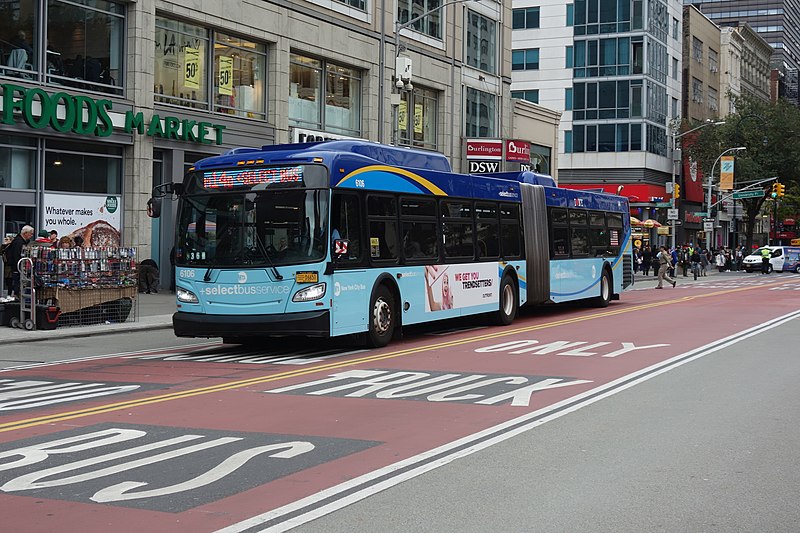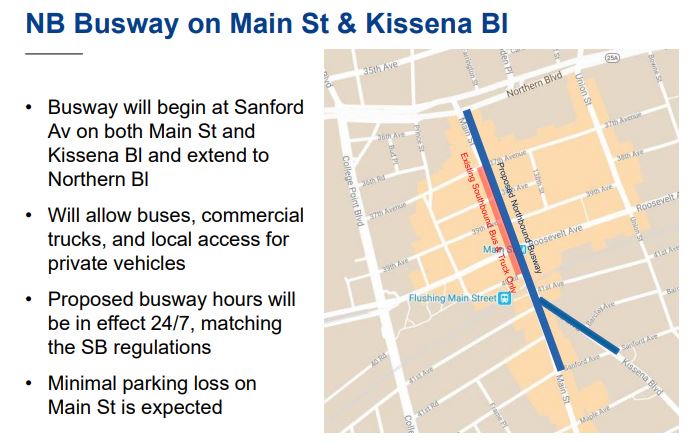
14th Street Busway in Manhattan (Photo: Tdorante10 CC BY-SA 4.0)
Oct. 1, 2020 By Christian Murray
The Department of Transportation is scheduling a meeting with the leaders of the Flushing Chinese Business Association to discuss its next steps in the installation of its controversial busway on Main Street.
The announcement of an upcoming meeting comes in the wake of the association calling on the DOT to postpone the plan, which the group believed was set to be installed on Oct. 1. The FCBA says it wants the meeting so its members can provide additional feedback on the plan and learn more about it.
The busway is planned to run 0.6 miles along Main Street from Northern Boulevard to Sanford Avenue and cars will be banned along the strip.
The MTA says the plan will increase bus speeds and improve service for approximately 155,000 bus customers each weekday.
The FCBA, in a letter sent by its attorney Randall Eng on Sept. 25, called on DOT Commissioner Polly Trottenberg to postpone the installation of the plan. Many business owners, Eng said, fear that if motorists can’t park their cars along Main Street, they will shop elsewhere.
The FCBA issued a statement yesterday saying that the DOT had agreed to delay the Oct. 1 installation of the busway and is looking forward to further discussions with the agency.
However, the DOT refuted this account saying that it never set a fixed date of Oct. 1 to install the busway—instead saying that implementation would be done sometime in October. It did acknowledge, however, that it will hold a meeting with the group.
“We are scheduling a meeting with the attorney and the parties he represents to discuss next steps on the project, which we have said we plan to begin implementing in October, though we have not named Oct. 1 as a specific date,” a DOT spokesperson said.
The FCBA’s Sept. 25 request to postpone the installation was supported by many local leaders—including New York City Council Member Peter Koo, State Senator Toby Ann Stavisky, Community Board 7 Chairman Eugene Kelty and Queens Chamber of Commerce President and CEO Tom Grech. They also said that additional meetings were needed.

The DOT, however, said that it has held several public meetings on the busway, including Community Advisory Board meetings on June 26 and Sept. 1; a Public Information Session in Chinese and English on Sept. 10; and a Public Information Session in English, Spanish and Korean on Sept. 14.
The FCBA is opposed to the plan in its current form. The organization wants it shortened and doesn’t want cars to be banned along the 0.6 mile stretch 24/7.
Public transit advocates, however, back the busway proposal.
They maintain that better bus service will increase the number of potential customers traveling to the area and would therefore bolster local businesses.
Eng, the attorney representing the FCBA, recognizes that the DOT is unlikely to scrap the plans. However, he hopes the plans can be changed.
“They might consider modifying the plan to blunt the impact of the project,” Eng said. “We are all for progress just not extremes.”
3 Comments

hello
This needs to stop the DOT is killing the businesses in the area enough is enough and most of the time the busses are in two lanes or the regular drivers lane and not just because of double parked cars
The exclusive bus only lane for Main Street in downtown Flushing missed something even more important.. Everyone has forgotten about the need for a new downtown Flushing Queens Intermodal Bus Terminal. There was seed money in the previous New York Metropolitan Transportation Authority $32 billion 2015 – 2019 Capital Plan to look into the possibility of the long forgotten Flushing Bus Terminal, which closed in 1954. It was originally located adjacent to the corner of Main Street and Roosevelt Avenue near the old Woolworth Department store. To date, there is no indication that these dollars have been spent. This need has been previously documented in planning studies going back to the 1960’s. Construction of a Flushing intermodal bus terminal could facilitate a smoother transfer between bus and subway. In the early 1960’s Flushing Municipal Parking Lot 1 was thought of for construction of an intermodal bus terminal. This facility would take hundreds of buses off the surrounding streets, where they discharge and pick up riders. For 56 years, generations of public officials, on a bipartisan basis, have failed to secure any funding necessary to support environmental review, design, engineering and construction of this badly needed transportation improvement.
From the 1960s to today, there has been an explosion in the number of commuters riding buses to Flushing and transferring to the subway. This has been complimented by a huge growth of commercial businesses accompanied by the demolition of homes to support construction of apartment houses and multi family homes in the surrounding neighborhood. Just walk in any direction from the corner of Main Street and Roosevelt Avenue in downtown Flushing and see for yourself. Buses traveling to, from and thru downtown Flushing move at slow speeds due to excess traffic not only during rush hour but also off peak. This results in a longer commute for riders and periodic bunching of buses on many routes.
Construction of a climate controlled intermodal bus terminal could assist in improving traffic and pedestrian circulation in and around the intersection of Main Street and Roosevelt Avenue along with the rest of downtown Flushing. Over 60,000 rush hour New York City Transit #7 subway riders and thousands more off peak would be protected from heat, cold, rain, snow and winds. There could be a smoother transfer between the bus and subway. Opportunities would still be available for air rights above the bus terminal for parking, joint development of retail, office and/or residential units, including affordable housing.
How disappointing that no elected official has ever stepped forward to honor this commitment from decades ago. Diogenes is still looking for any NY MTA board member or public official to add this project to the MTA’s current $51 billion 2020 – 2024 Capital Plan.
In the interim, a short term improvement could be construction of bus holding lights at bus stops. This would assist riders transferring from subway to bus when a train arrives several minutes after scheduled bus departures. Missing a bus by a minute or two during off peak hours (when buses operate with longer intervals) is frustrating to riders. Why not also invest in installation of bus holding lights at other major bus to subway transfer connections as well?
(Larry Penner is a transportation advocate, historian and writer who previously worked 31 years for the Federal Transit Administration Region 2 New York Office. This included the development, review, approval and oversight for billions in capital projects and programs for the MTA, NYC Transit, Long Island and Metro North Rail Roads, MTA Bus, NYC Department of Transportation along with 30 other transit agencies in NY & NJ)
.